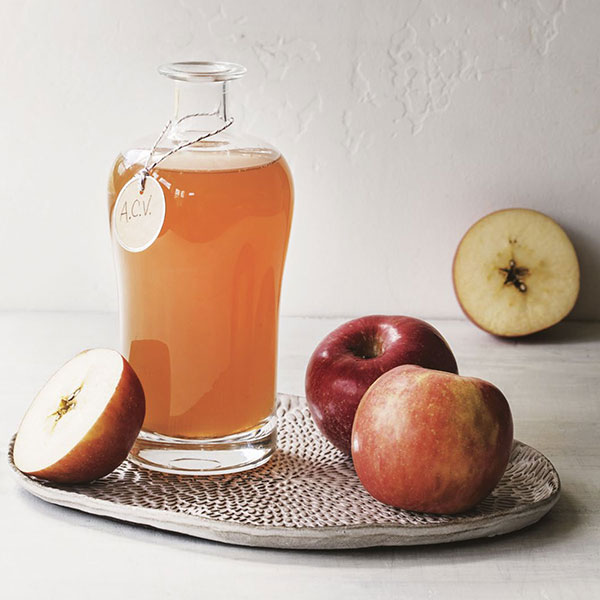Apple Cider Vinegar
Make your own delicious apple cider vinegar at home with this easy-to-follow recipe!
That’s right, you can make your own delicious apple cider vinegar, whether you start from your own pressed apple juice, store-bought apple juice, or already fermented hard cider. Apple juice falls beautifully in the specific gravity range for the perfect alcohol to create a good acidic vinegar.

I have never had to adjust with any extra sugar so there isn’t a need to measure specific gravity or Brix for successful vinegar, but if you keep a vinegar log and have the tools, you may want to keep track of this.
Apples are also naturally acidic fruit. This lower pH means that you won’t have to bring the pH down with lemon juice to help get a strong fermentation without surface yeast. This, and most of the recipes in Homebrewed Vinegar don’t strictly need a vinegar starter; vinegar will happen on its own. In my years of making vinegar, though, I’ve found that the success rate is so much higher with the inoculation, there’s no reason not to use a starter unless you simply don’t have access to raw vinegar.
This recipe makes a gallon.
Ingredients:
- 1 gallon (3.8L) apple juice, freshly pressed or pasteurized
- 1⁄2 teaspoon (1 g) wine yeast (optional for freshly pressed juice, needed for pasteurized juice), hydrated in 1⁄4 cup (59 mL) unchlorinated water, warmed to 104°F/40°C; or 1⁄2 cup (118 mL) room-temperature wild yeast starter
- 1 cup (237 mL) raw, unpasteurized, unfiltered vinegar, or a vinegar mother
Directions:
- Fill a sanitized 1-gallon jar with juice, leaving about 2 inches of headspace.
- Add the hydrated yeast or the wild yeast starter to the jar. Alternatively, if wild fermenting, skip to step 4.
- Cover the jar with a piece of unbleached cotton (butter muslin or tightly woven cheesecloth), or a basket-style coffee filter. Secure with a string, a rubber band, or a threaded metal canning band. This is to keep out fruit flies.
- Place in an environment where the temperature is between 55° and 65°F/ 13° and 18°C. Wild yeasts seem to do better at this temperature range. Unlike some active commercial yeasts, wild yeasts are typically slow to start, so don’t expect to see bubbles for a couple of days or more.
- At 7 to 10 days, add the raw vinegar. Replace the cover on the jar. Store on your counter or in another spot that is 75° to 86°F/25° to 30°C.
- Check the vinegar in a month, when you should have nice acidity. However, it may take an additional month or two to fully develop, especially if your environment is cooler.
- Bottle the finished vinegar, saving the mother for another batch or sharing with a friend. Use immediately, or age to allow it to mellow and develop flavors.
NOTE: Because this cider is destined to become vinegar, this recipe uses an open container that gives the cider lots of air contact. If you decide you want to drink a bit of the cider and make vinegar with the rest, it’s important to use a narrow-mouthed bottle fitted with an airlock during the first fermentation.
This recipe is for a gallon, simply because gallon containers are easy to procure. You should feel free to increase or decrease it, as needed. Many apple cider vinegar recipes online call for cutting apples into chunks and adding sugar and water. While you will get a similar flavor, you will not get the same product. If you want true apple cider vinegar with all its nutrients, you need to start with real apple juice.
Tried this at home? We’d love to see! Share your photos with us on Instagram @kirstenkshockey and @storeypub.
Excerpted from Homebrewed Vinegar © Kirsten K. Shockey. Photo © Carmen Troesser.
Apple cider vinegar has a long history as a folk remedy for a variety of health conditions and, as a result, has achieved something akin to cult status among natural health enthusiasts. But many people don’t realize that there is a whole world of options beyond store-bought ACV or distilled white vinegar. In fact, vinegar can be made from anything with fermentable sugar, whether leftover juicing pulp or brown bananas, wildflowers or beer. With her in-depth guide, Kirsten K. Shockey takes readers on a deep dive into the wide-ranging possibilities alive in this ancient condiment, health tonic, and global kitchen staple. In-depth coverage of the science of vinegar and the basics of equipment, brewing, bottling, and aging gives readers the foundational skills and knowledge for fermenting their own vinegar. Then the real journey begins, as the book delves into the many methods and ingredients for making vinegars, from apple cider to red wine to rice to aged balsamic. Along the way, Shockey shares insights into vinegar-making traditions around the world and her own recipes for making vinegar tonics, infused vinegars, and oxymels.












